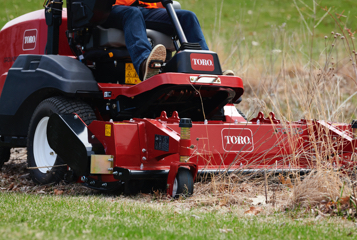- CONTACT US
- MOWERS
- VEHICLES
- APPLICATION
- Golf
- AERATORS
- VEHICLES

NEWS FOR COUNCILS, CONTRACTORS AND LANDSCAPERS
NEWS FOR COUNCILS,
CONTRACTORS AND LANDSCAPERS

IN THIS ISSUE
ALL STORIES

Product Test:
Toro Groundsmaster 7210
Share this story: Twitter | Facebook | LinkedIn
Product Test:
Toro Groundsmaster 7210
by James de Havilland

FIRST IMPRESSIONS
When I first tried a Toro Groundsmaster 7210 some years back, I was struck by just how easy it was to use. Expecting the same this time round, I was surprised by my inability to do a tight, scuff-free turn. I also wondered if I was a bit off-line too. Was it me or was the demo machine at fault? Chris Walker, Reesink’s demonstration manager, took over the controls and I quickly realised my ‘skid steer’ memory was the culprit. It takes time to master the controls of a zero-turn mower, regardless of make or model. This is a point to consider when trying a machine like the Groundsmaster 7210 on a demonstration, to benefit from its potential productivity boost the operator needs to know how to exploit its agility and super-fast return to mowing during a turn.
James de Havilland
Manoeuvrable productivity
No matter how you do it, keeping grass in trim costs time and money. It’s no surprise that high output mowers are favoured in sectors from sports and fine turf through to parks and amenity areas. A problem for many, however, is not just the total area that needs to be mown, but access to those tight spots that are really difficult to get at. Manoeuvring to deal with these can compromise daily outputs or even lead to an increase in demand for pedestrian mowing. A possible solution is a mower like the Toro Groundsmaster 7210.



These three photos show how slewing a zero-turn mower around when mowing up to an obstacle or barrier reduces the time that would otherwise be lost shuttling back and forth. The more awkward the area to be mown, the more effective a zero-turn becomes.
Zero-turn mowers have a long-established niche with users across many sectors, both the 7210 we’re testing here and its smaller horsepower series counterpart, the Groundsmaster 7200 have become established as dependable, rugged and economical choices. Sharing essentially the same chassis and running gear, the 24.8hp Groundsmaster 7200 and 36.8hp 7210 can be supplied with decks of up to 1.82m giving 72 inches of cut with rear discharge, proving the deck of choice on the more powerful 7210. This is the model we’re testing, although this model can be specified with a wide 2.54m deck with folding outer wings as one of several options.

The 7210 has been around long enough to have a strong following, but it can suffer from, as is often the case, being so familiar it gets overlooked. Zero-turn mowers tend to either have loyal users or those who just view the whole zero-turn concept as compromised. For others, a zero-turn is fine for small, awkward mowing but no good for wider areas. The perception that lever steering makes these mowers difficult to keep in a straight line, particularly across a slope, persists. Some still consider these mowers, in general, too ‘tricky’ to consider for general use.
A quick demonstration of a 7210 will not necessarily sell the concept either or dispel the misconception. Ten minutes into trying the 7210 for the first time in a couple of years, I found myself straying off-line and the first few tight turns proved a jerky, turf tearing mess. It takes more than a little time to familiarise yourself with the controls, despite Toro having the travel come steering lever response on the 7210 really nicely balanced. Suggesting anyone can just jump on the machine and expect to deliver a smooth and accurate mow is misleading. That takes practice.

Second nurture and intuitive
Handing over the reins to Chris, he demonstrated how working the steering levers needs balance in a really tight turn, matching the speed of the outer driven wheel to a touch of reverse on the inner one to achieve a scuff-free about-face turn. Bringing the mower around so it is parallel to the previous pass does take a little bit of practice. This makes the task sound difficult when in fact it is pretty much something you ‘re-remember’, if you are familiar with the ‘skid-steer’ steering concept. It becomes second nature and intuitive, just do not expect to master the concept immediately.

Tricks made easy
So how do you demonstrate the performance gains a 7210 can offer over a typical out-front rotary such as a Groundsmaster 3200? With difficulty is the short answer. Everything will hinge around what needs to be mown. A large square area is an easy cut. The same area with obstacles, tight dead-end turns and awkward boundaries is something else all-together. In a straight ‘fight’, an out-front rotary may possibly have the edge for the former, a zero-turn winning out for the latter.
Inclement weather pretty much prevented us trying the 7210 in the tight formal areas that would have proven not just its agility but how it can turn tightly and cleanly within pretty much its own length. The open ground we could access did present a few challenges, however, and here the ability to pretty much mow ‘square’ into corners and turn back onto a narrow path without shuttling highlighted a key zero-turn plus.

Seeing is believing
Is a zero-turn mower the answer to your specific mowing needs? On the evidence of a brief test run over less challenging work it is difficult to say. The main consideration is that there are choices that can make a model like the Groundsmaster 7210 well worth putting on your list to try. Give the mower a chance. You need to work with the mower and understand it to exploit its performance enhancing agility.

FEATURED STORIES

Stage V for cleaner air
2019 saw the biggest developments yet for non-road mobile machinery with the introduction of Stage V emissions regulations in the European Union.
Here we talk to Chris Cooper, senior product marketing manager at The Toro Company, about what Stage V means for turfcare customers in the UK in 2020.
READ FULL STORY >
Machine Focus: Groundsmaster 3300
Stage V is a hot topic ahead of transitioning this summer and the Groundsmaster 3200 and 3300 lead the first wave of new Stage V emissions compliant machines from Toro.
Not only do these machines deliver on the new emissions standards but on the new ways councils and contractors are cutting.
READ FULL STORY >
Living wall wins
Maintenance of one of Europe’s biggest vertical living walls next to a Metro line in Birmingham can only happen at night just twice a year.
Unique, progressive and innovative, it was the winning project for Nurture Landscapes in Toro and Reesink’s sponsored BALI award.
READ FULL STORY >Reesink UK LTD | 1-3 Station Road, St Neots PE19 1QF | Registered in England
Reesink UK LTD is authorised and regulated by the Financial Conduct Authority.








